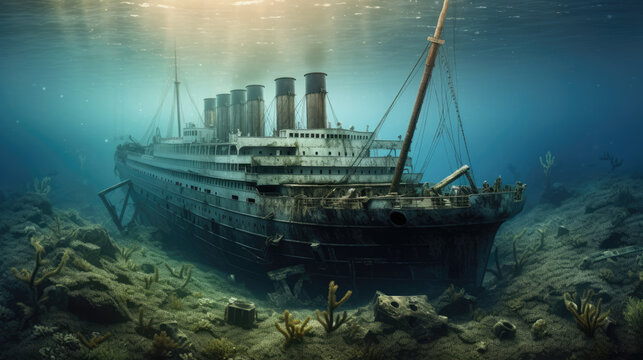When the accident happened, the Titanic was traveling from Southampton, England to New York in the United States of America at a speed of 41 miles per hour, and after only three hours, the Titanic sank in the Atlantic Ocean. The night was April 15, 1912.
This ship that was said to be unsinkable has sunk. 1500 people died in the accident. It is considered to be the worst sea disaster even after 111 years.
The wreckage was recovered from the crash site in September 1985. In this crash, the ship broke in two 3,843 meters, 650 miles from Canada, and the two parts were separated by a distance of 800 meters. .
Even after 111 years of the accident, there is still a semblance of mystery surrounding the accident. The BBC News Brazil branch tried to find answers to the secrets and connections of the unknown questions about the Titanic so far by talking to various experts as we present to you in this story.
1. “Even God couldn’t help it!!!”
It was said that this ship was built with such skill that it would not be able to sink. Those who did it went too far and said that “even God himself could not forgive them”. There is a reason why people have this belief.
Alexander de Pinho Alho, professor and lecturer at the University of Rio de Janeiro in the Department of Gemstones says that “in terms of mining technology, the Titanic was the first ship to be built based on the technology that is important in its structure . Some watertight compartments were built inside the ship so that while one compartment could fill with water, it would not cause the other to sink.”
There were some problems during the preparation of this ship, there was a lot of thinking about how tall this ship was required to be installed, so that the electrical cables and water tanks could do the job properly.
According to Prof. Alho went on to say, “After careful and careful consideration, they had decided on the height of the boat, and even during the flood, they felt that the water could not protect this boat up to the height of its roof. Also, they have built security rooms on the roof.”
However, no one would have thought that there would be such a big collision with an iceberg.
Professor Alho says, “The biggest risk was that there was a hole that was half the length of the ship. In that situation, the water reached the roof.”
“The boat is full of water, in that case, rescue and rescue is impossible, you can turn on all the pumps to remove the water from the boat, you can try all the ways, but the speed of the water entering the boat is equal to that of the exit. He can’t get out soon.”
Thierry, a shipbuilder and veteran sailor, says that “Titanic had to be built in such a way that it could not sink. This is because many holes are created in the waterproof walls. In the basement, the ship could not sink even when it was flooded. But the collision with the iceberg caused severe damage to the ship and many watertight walls were destroyed.”
Aurilo Soras Murta is a professor at the University of Fluminense, who teaches in the Department of Transportation, he says that “The system that was used to close the Titanic’s watertight part was not working as well as it was supposed to.”
At that time the steel used to make boats was not as strong and strong as the strongest steel that could be used in those days.
“The shape of the ship had also changed after it collided with the rock and hit each other with great force. The doors were not closed, they were closed. Oh, and at that time, the Titanic was made of pure steel but the steel of that time was the same as the steel of today. It had no power, it was not strong.”
John Vaitavuk, a professor of mining at the Mackenzie Persebyterian University of Sao Paulo, explains that until the 1940s, most ships were made of steel.
However, after the steel used to make most of these ships was first melted down.
2. Be persistent in giving others access to the “Blue Band”
After this great disaster, humanity’s fault will always be found in the reasons for their actions.
According to experts, there is a lot of pressure on the ship to complete the trip soon despite the perceived difficulties of crossing the iceberg.
In fact, this pressure was what reached the “Blue Band”. Beginning in 1839, this honor and award was given to the ship that could cross the Atlantic Ocean the fastest. Titanic was therefore seen as a ship in a better position to compete for this honor than any other due to the way it had been designed.
Professor Alho says that if you look at the times, the engineering skills and advanced technology were used to build the Titanic. At that time, there was competition between the world’s leading companies in the production of these ships. At that time, between England and Germany, there was a great rivalry to build the longest and fastest ship.
The largest and fastest ships were officially awarded the Blue Band. The first voyage was considered the most important for any ship in achieving this feat.
According to Alho, “The more stable the ship is on the first voyage, the faster the ship can reach on the first voyage, and the Titanic also tried to increase the speed.”
Many of the survivors of the accident said that the captain of the ship was informed that there was an iceberg in the area they were about to reach, but he did not reduce the speed of the ship when he was trying to cross the Atlantic Ocean in that area. what he wanted to achieve was the goal he had set himself.
3. It’s not just Titanic
Titanic was not alone. The White Star Line, which operated this ship, ordered three more ships to be built at the Harland and Wolff shipyards in Belfast in the early 20th century.
It was expected that these three ships, built by a team of international inventors and innovators, should be longer, safer and better equipped. “These projects were well-publicized at the time,” says mining expert Stump.
These boats were built between 1908 and 1915 and were called Olympic class boats. The construction of these two ships began, the Olympic began in 1908 and the Titanic in 1909. While the construction of the third ship named Gigantic began in 1911.
However, all three ships were involved in accidents at different times. The Olympic cruiser entered service in June 1911, and that year collided with a battleship. It was repaired and resumed operations and services.
During the First World War, the British Navy used these ships to transport soldiers from one place to another.
In 1918, the battleship Gigantic collided with German submarines. After its construction, it started working again from 1920. It is considered to be an old and reliable ship, which was used until 1935.
Titanic made her maiden voyage on Thursday 10th of 1912. She had previously survived another collision with another ship off the coast of Southampton.
But no one saw him jump. On April 14th, he did not jump and made the most famous accident in history.
Great boat but not used much. Its name was changed to Britannic. The British Navy converted it into a hospital during the First World War. This ship sank in the 11th month of 1916.
All three of these ships were very large in their time but they are small compared to the time we are here.
“Compared to the big ships of today, those were like small boats,” says Murta.
The length of the Titanic was 269 meters. Including crew and passengers, it had room for about 3,300 people. The largest ocean liner is the Wonder of the Sea, which is 362 meters long and can carry 7,000 passengers. 2300 employees.
4. Why did so many people die?
Nearly 1,500 people died in the Titanic disaster, after which the safety of submarines began to be studied and tightened. After the accident, radar-like devices began to be used to monitor marine vehicles.
“The use of radar began shortly after World War II. Before that, everything depended on how a person looked with his eyes. The passenger was sitting on top from where he could warn the crew when he saw an iceberg approaching the ship. This is the way that was used, it was not safe enough, of course, when the boat would be moving at a high speed,” explains Professor Alho.
Titanic safety regulations have been tightened, and people are being asked to comply. Many people died in the sinking of the Titanic because there were no small rescue boats to save their lives.




